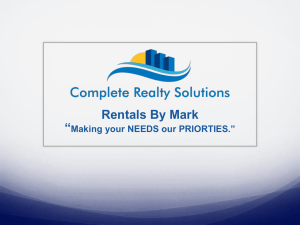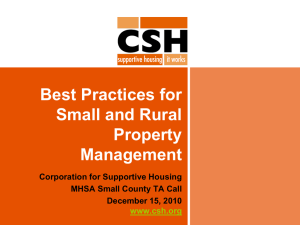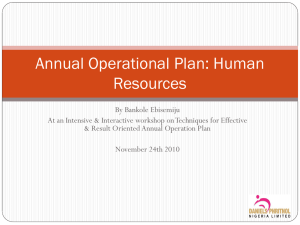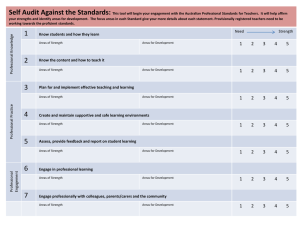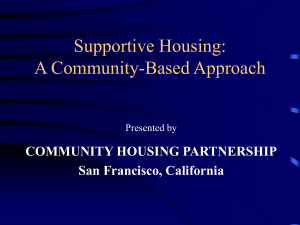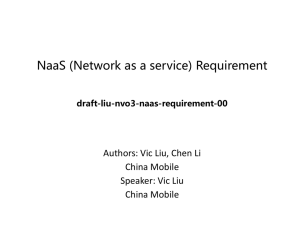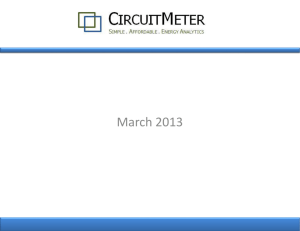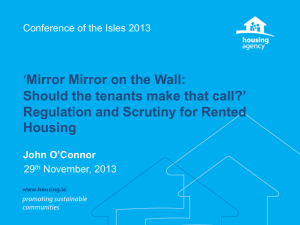Coordination of Property Management and Supportive Services in
advertisement
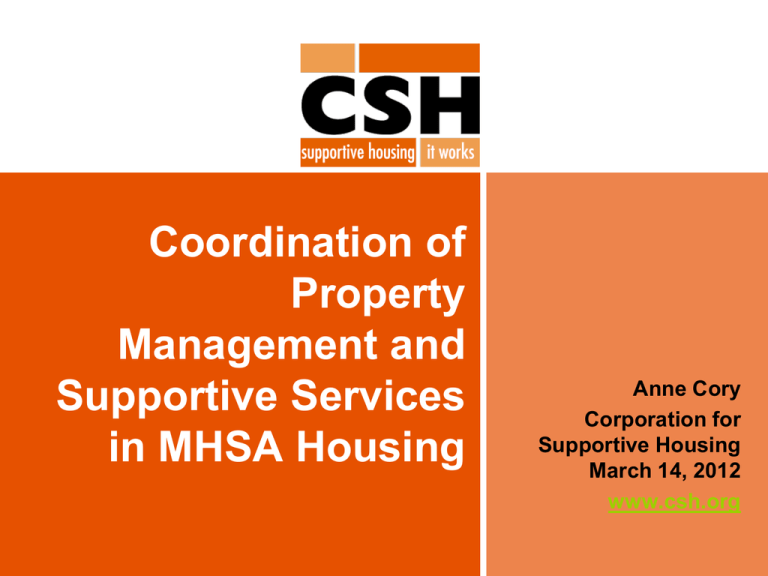
Coordination of Property Management and Supportive Services in MHSA Housing Anne Cory Corporation for Supportive Housing March 14, 2012 www.csh.org MHSA Housing Program 2 The MHSA Housing Program makes permanent financing and capitalized operating subsidies available for the purpose of developing permanent supportive housing, including both rental housing and shared housing, to serve persons with serious mental illness who are homeless or at risk of homelessness. Define Supportive Housing 3 A cost-effective combination of permanent, affordable housing with services that helps people live more stable, productive lives. Housing & Services 4 HOUSING – PERMANENT: Not time limited, not transitional; – AFFORDABLE: For people coming out of homelessness; and – INDEPENDENT: Tenant holds lease with normal rights and responsibilities. SERVICES – FLEXIBLE: Designed to be responsive to tenants’ needs; – VOLUNTARY: Participation is not a condition of tenancy; and – INDEPENDENT: Focus of services is on maintaining housing stability. Effective Coordination of Property Management and Supportive Services Coordination of Property Management & Supportive Services 6 One of the defining characteristics of permanent supportive housing is the coordination of property management and supportive services to support the goal of housing retention for tenants. For effective coordination, it is critical to understand this housing model and how it differs from other housing models and to have clearly defined roles and responsibilities. Traditional vs. Supportive Housing Property Management Traditional Rental Housing Supportive Housing The property manager makes all decisions regarding lease violations and evictions. The property manager is solely responsible for low vacancy rate and rent collection. The property manager works with resident to make payment plans. Collaboration between property manager and service provider regarding lease violations and evictions. Property manager works with service provider to maintain a stable housing environment. Service provider involved with payment plans, and “contracts” to maintain housing. 7 Mission-Driven Property Management 8 “Double Bottom Line” Mission-driven property management practices include… – Development and enforcement of house rules – Collaborative approaches to tenant selection and screening, move-in, orientation, and crisis management – Resident councils – Creation of job opportunities for tenants – Record-keeping – Evictions and problem-solving Key Principle for Coordination Establish Clear Roles and Responsibilities 9 Outline clear roles Establish forum for discussing and renegotiating roles and responsibilities Another Key Principle for Coordination Recognize Overlap and Built-In Tension between Roles 10 Acknowledge compatible and conflicting goals 11 Compatible/Mutual Goals – Ensuring the effective operations of the building. – Providing safe, secure and affordable housing. Acknowledge compatible and conflicting goals 12 Conflicting Goals/Tensions – How to balance the needs of the individual tenant with the needs of the entire community? – How to balance the needs of tenants and the need to maintain the facility? – Advocating for tenant’s rights can threaten property management functions, for example, creating tenants’ organization, which decides to withhold rent. Embracing Good Tension 13 Respect the different roles of each partner Understand all roles are necessary and important for a well-managed building Acknowledge and use built-in tension between roles and functions to ensure stability and a sound asset Roles and Challenges How can we prevent this from happening again? How can we help the resident keep their housing? Social Services I just want to help! Property Mgt Show me the money! Find root cause Are we going to have to evict? Should we start processing applications? Common Issue: Resident can’t pay rent Stabilization and planning Identify services or agencies to assist 14 Goal: Provide the tenants the support they need to reach their fullest potential and to keep the building in compliance with funding sources, physically, and financially. Roles and Challenges Social Services I just want to help! Property Mgt Show me the money! Common Goal: Keeping Residents Housed Blended Mgt requires that we come in from all angles. 15 Goal: Provide the tenants the support they need to reach their fullest potential and to keep the building in compliance with funding sources, physically, and financially. Coordinating Management and Services Supportive housing = coordinated property management and supportive services functions Collaborative relationships are essential Balance competing forces Financial demands of the building Security of larger tenant community Needs of individual tenants 16 16 Service Provider Role 17 Design and implement the Supportive Services Plan Participate in applicant tenant screening and help applicants address barriers Engage tenants in services to support housing stability and life goals Serve as the tenant’s advocate with property management Help tenants define how they can comply with property management requirements Service Provider Role (cont’d.) 18 Crisis management; assist in dealing with disruptive tenants Participate in community building & organizing Participate in developing and revising House Rules; help develop and implement emergency policies & procedures. Maintain records of services provided Property Management Role 19 Participate in the process of developing the project design Manage the rent-up process, including marketing, outreach, interviews, and tenant selection Provide orientation to incoming tenants Enforce the leasing agreement; coordinate with the support services team and the tenant, to address issues jeopardizing housing retention Property Management Role (cont’d.) 20 Participate in community organizing, including working with tenant leaders Hire, train and supervise property management staff Routine maintenance and health and safety issues Overall fiscal management and accounting responsibilities for project Maintain compliance with government and private funds and other regulatory or fiscal compliance Roles and Responsibilities RESPONSIBILITIES OF RESPONSIBILITIES OF SERVICE STAFF PROPERTY MANAGEMENT STAFF Focus on service history and current needs during Focus on ability to pay rent during management interview service interview INTAKE: TENANT SELECTION Both Service Staff and Property Management conduct the tenant interview, focusing on characteristics of a good & INTERVIEWING neighbor. Common concerns during Intake: Who makes the final decision? How much information can be shared from the service interview? Help tenants with concrete needs around the move in, Orient tenants about building maintenance issues, fire drills, such as unpacking, getting familiar with the building and tenant meetings ORIENTATION OF routine and location of laundry, neighborhood resources, INCOMING TENANTS staff locations and responsibilities Provide tenants with assistance in paying their rent (e.g., Responsible for collecting rent and addressing issues of rent arrears RENT PAYMENT & ARREARS budgeting, addressing cost of substance abuse, vocational services, etc.) House rules are generally developed jointly by Services and Management. Some basic rules may be developed by staff DEALING WITH NUISANCE & and tenant input to add or revise these. All staff can help promote healthy cultural norms for the building; it is DISRUPTIVE BEHAVIORS frequently Service staff who help to structure these efforts. Clear policies and procedures should be in place for dealing with disruptions. These should clearly spell out the chain of PROCEDURES IN CRISES (e.g., psychiatric, medical, physical command in case of emergency, what information to provide to EMS, when to beep staff on call, etc. or fire) Staff and tenants should be aware of systems for evaluating the program and the services given. Management and TENANT GRIEVANCE Service staff generally work together, with Service staff alerting tenants to procedures through individual case PROCEDURES management meetings or tenant meetings. TENANT COUNCIL COMMUNITY BUILDING 21 Facilitate initial tenant meetings with the goal being to Attend meeting when issues concern the building or eventually have tenant run meetings. maintenance. Many issues mentioned above involve aspects of community building. The tenants as well as management and service staffs are members of the building community and influence the culture of the community. Staff should be aware of trends in the community and plan strategies for positively influencing the culture. Putting Principles into Practice 22 Develop an MOU or contract between partners Develop a guiding principle statement that spells out the working approach Carefully select, train, support, and supervise social service and property management staff Develop written job descriptions with clearly defined roles Schedule regular communication Give staff parallel status and authority Outline written procedure for resolving disagreements Building and managing your relationships 23 Working together requires more communication. Clear, written guidelines are followed by all. Coordination will always be a work in progress. Define the situations that require shared decision-making. Identify the tools you will use to support the collaborative approach. “Predictable Crises” 24 In hindsight, crises during operations often seem predictable because they were born in quiet acts of omission and commission. Example. Because social services and management were all just ‘sort of’ working together without a coordinated mission or procedures, they did not have any of the steps in place to act when needed. Resolving Problems 25 Even with a shared goal, specific circumstances will often cause the different priorities of property management and supportive services to clash. Conflicts of opinion should not be buried or ignored. Instead, these conflicts need to be acknowledged, discussed openly within the context of the shared building goals, and be resolved. Keys to Success 26 Select, train and supervise property management to ensure knowledge of special needs issues. Provide opportunities for training, mutual education, clear communication and mutual responsibility among the service providers, property manager, and the tenant council. Ensure that the decision-making and consultative roles of the tenant council are clear to all parties. Provide a clear procedure for resolving disagreements between the management and support services perspectives, and foster team building among on-site staff. Keys to Success 27 Similar mission and goals Have it in writing Earn trust over time Everyone contributes to the partnership Clear and constant communication In it for the long-haul Sharing and collaboration Mutual respect Indicators of Effective Coordination Coordination of Property Management & Supportive Services Core Indicators Property management staff has a clear understanding of supportive services, staff roles and responsibilities. Supportive services staff have a clear understanding of property management staff and/or landlord roles and responsibilities Supportive services staff promptly notifies property management staff when they observe safety or maintenance issues. Property management staff and/or landlords know who to contact when there is a tenant behavior related issue or need. Services staff proactively address issues that may impact tenants’ housing stability, particularly in response to property management and/or landlord concerns. 28 Indicators of Effective Coordination Coordination of Property Management & Supportive Services Core Indicators There are regularly scheduled forums for property management staff and supportive services staffs to discuss their roles, the coordination of their efforts, current issues, and to address gaps in services and operations. Services staff advocates on tenants’ behalf with property management and/or landlords when necessary and appropriate to maintain tenants’ housing stability. Property management and supportive services staff work together to support eviction prevention practices including rent repayment plans, procedures for addressing property damage, and harm reduction (when applicable) to support resident housing stability. Property management records are stored separately from supportive services records. 29 Consider Tenants’ Adjustments 30 Rent must be paid every month Adjusting to a new neighborhood Learning to or regaining the ability to live independently Neighbors may have special needs Tenants (and their visitors) are expected to follow the house rules Socialization Sample Coordinated Responsibilities List 31 Sample case: A frail, mentally ill man is beginning to decompensate and has been screaming in the night. Service staff has been working with his doctors to adjust his medications and his behavior does not warrant hospitalization. But his neighbors are complaining and angry at both management and services for not doing anything about their complaints. Confidentiality in Supportive Housing Principles of Confidentiality 33 Why is confidentiality important in supportive housing? What should be shared between property management and supportive services? What must be shared to effectively manage supportive housing? Why? What should NOT be shared? The purpose of maintaining tenants’ confidentiality 34 Protect tenants’ right to privacy. Protect tenants from information being disclosed, which could potentially be used against them. Encourage tenants to establish trusting relationships with staff. However……. 35 Information about a tenant should be shared with other staff members within your organization if it is required for them to do their jobs; namely, to protect a tenant’s safety or to enhance their well-being. Some Reasons to Share Tenant Information 36 Improve an agency’s ability to determine how to work most effectively with the tenant to achieve their goals. Service coordination with other agencies. Reduce duplication of services. Avoid asking tenant for the same information over and over again. Evaluate the overall effectiveness of programs. Monitor services provided and resources used. How do we define the lines? 37 Because there is a great deal of misconception about what is confidential information, service staff may appear withholding or secretive when it comes to providing information to support staff. This may frustrate support staff. It is important for all programs to establish what is confidential, plus what can be shared by all levels of staff. What is not considered confidential? 38 Observable, public behavior. Information obtained not in the course of professional service (hearsay, casual conversation). Communication Also, there are ways in which services can communicate with property management, which does not divulge confidential information. Instead of saying, “The tenant is on 100 mg. of methadone and seeing a psychiatrist,” it can be said, “The tenant is receiving treatment, and we can expect she will stabilize soon.” 39 Between the Lines 40 What types of information may be shared across supportive services and property management teams without violating confidentiality? Between the Lines 41 Generally, property management staff should only have information related to an applicant or tenant's ability to meet the terms of tenancy. When supportive services staff and property management staff need to share information, staff should first obtain the tenant's consent. Between the Lines 42 Supportive housing programs present unique privacy challenges for the service provider and the housing provider. Although sharing information between the two may occasionally allow for a more informed treatment program, some information sharing may violate privacy laws. Between the Lines 43 A housing provider should never reveal to other tenants that a particular tenant has a particular disability, unless such disclosure is specifically authorized by the tenant with the disability. However, this prohibition does not mean that the provider may not reveal in marketing materials that the project or some units in the project are targeted to specific populations or limited by funding sources to tenancy by a particular group of disabled persons. Moreover, if one application is used, applicants are likely to notice questions that pertain to MHSA eligibility. Guidelines and Tools for Sharing Information 44 If a non-support services staff member observes a tenant’s behavior that he or she believes indicates a problem or a need for services, recommended strategies for addressing the issue include: Guidelines and Tools for Sharing Information 45 The staff member may offer to introduce the tenant to a services team member. If the tenant’s behavior occurs regularly in a public area, the staff member can ask a member of the services team to be present to observe the behavior. When a non-support staff member shares information with a services team member, information about an incident or problem should be limited to direct observation, not judgments, hearsay, rumor, or interpretations. Guidelines and Tools for Sharing Information 46 Property management may report to a services team member a disruptive episode involving the tenant that occurred when the team members were not there. Tenants who are bothered by other tenants’ behaviors sometimes ask for information about how other tenants’ issues are being dealt with. Staff will need to assure tenants that issues are being addressed without sharing protected health information. Staff must consistently express to all tenants what information is confidential and what is not. RESOURCES Resources Supportive Housing Property Management Operations Manual Created by CSH and partners in 2003 Designed specifically for supportive housing Managing and operating supportive housing is different The core mission of supportive housing is to provide quality affordable housing for people with disabilities who are homeless or at risk of homelessness. 48 Toolkit CSH’S TOOLKIT FOR DEVELOPING AND OPERATING SUPPORTIVE HOUSING @ WWW.CSH.ORG/TOOLKIT2 49 Toolkit 50 HOUSING OPERATIONS Introduction to Property Management in Supportive Housing Tenant Screening, Selection, and Move-In Leases, Lease Enforcement, and Rent Collection Reasonable Accommodations in Supportive Housing Operations Safety and Security Maintaining the Physical Plant Toolkit 51 SUPPORTIVE SERVICES Designing the Supportive Services Plan Essential Service Strategies for Supportive Housing Settings Preparing for Tenants’ Service Needs Resource 52 BEST PRACTICES MANUAL: INTEGRATING PROPERTY MANAGEMENT AND SERVICES IN SUPPORTIVE HOUSING Resource 53 Not a Solo Act: Creating Successful Partnerships to Develop and Operate Supportive Housing. Updated edition, 2012. Supportive Housing Training Series 54 Produced for HUD by CSH and CUCS Introduction to Supportive Housing Development Financial Management and HUD Compliance Coordinating Property Management and Social Services in Supportive Housing Developing the Program Supportive Housing Training Series (continued) 55 Community Building in and Around Supportive Residences Services for People with Special Needs Case Management Services Crisis and Conflict Issues in the First Year Making the Transition to Permanent Housing Employment Services in Supportive Housing • The Seven Dimensions of Quality for Supportive Housing: • Definitions and Indicators • Quality Assessment Tools Additional Materials and Resources Dimension #5: Property and Asset Management 56 For MHSA Housing Program TA Anne Cory 510.251.1910 x208 Alan Saunders 510.251-1910 x214
